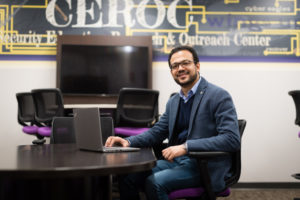
Xiang Sun, University of New Mexico
|
Title: Wireless Federated Learning for Mobile Edge Computing
Abstract:
Federated learning (FL) is an emerging approach that enables different clients (i.e., devices) to collaboratively and distributively train machine learning models at the mobile edge. As compared to the centralized machine learning model training process, FL can preserve clients’ privacy and potentially reduce network traffic load as users are not required to share their raw data to third-party computing facilities. FL has been proposed to be applied in various applications, such as eHealth, next word prediction, and additive manufacturing. However, FL is still in its infancy, there are still many challenges, such as efficient client selection and model aggregation to reduce the learning time, and malicious client detection for robust FL. This tutorial will provide the introduction of FL and its applications, overview state of the art FL technologies, and highlights the challenges of FL and the potential solutions.
Biography:
Dr. Xiang Sun is an assistant professor with the Department of Electrical and Computer Engineering at the University of New Mexico. He received his Ph.D. degree in Electrical Engineering from New Jersey Institute of Technology (NJIT) in 2018, and his M.E. and B.E. degrees both from Hebei University of Engineering in 2011 and 2008, respectively. His research interests include free space optics, wireless networks, cooperative machine learning, Internet of Things, edge computing, and green communications and computing. He has received several honors and awards, including NJIT Ross Fellowship 2014-2015, 2016 IEEE International Conference on Communications (ICC) Best Paper Award, 2017 IEEE Communications Letters Exemplary Reviewers Award, 2018 NJIT Hashimoto Price, and 2019 IEICE Communications Society Best Tutorial Paper Award. He is an associate editor of the IEEE Open Journal of the Computer Society and Digital Communications and Networks. |

Muhammad Ismail, Tennessee Tech University |
Title: Data-Driven Resource Management in 5G+ Wireless Networks
Abstract:
Recent trends in 5G and beyond (5G+) wireless networks have encouraged the migration from the already congested radio frequency (RF) spectrum to higher frequency bands. However, the signals at such bands suffer from severe deterioration in quality due to link instability induced by users’ mobility. In this context, this tutorial discusses one possible solution, namely, seamless integration of heterogeneous networks through intelligent vertical handover policies. Due to the ubiquitous presence of lighting systems, this tutorial focuses on the integration of LiFi networks (operating in the visible light band in the downlink and infrared band in the uplink), as an example of 5G+ network, and RF networks. First, to develop a better understanding of the channel characteristics of LiFi networks in presence of users’ mobility, this tutorial presents a method to generate realistic channel dataset. The mobile channel generation method creates realistic human mobility traces that capture human behaviour on macro- and micro-timescales. The mobility traces are then used to realize the spatio-temporal characteristics of the LiFi wireless channels under long-term environment-confined mobility. Statistical analysis of the generated channel data proves that there does not exist a general mathematical model to accurately describe the LiFi channel under environment-confined user mobility. In turn, this motivates the adoption of a data-driven approach to design effective and intelligent vertical handover policies among LiFi and RF networks. A wise handover policy would not trigger lots of handovers for short absence of LoS links in the LiFi channels as this would increase the overall network latency. Hence, a data-driven algorithm will be presented to: (a) predict abrupt outages in Line-of-Sight (LoS) LiFi links and evaluate the channel quality through deep learning and (b) implement optimal vertical handover decisions with the quality- of-service (QoS) guarantee if the LiFi channel is deemed to be in extended outage, via a reinforcement-learning-based approach. This tutorial will highlight the challenges that face the development of such a data-driven framework. Specifically, due to the sparse nature of the LiFi LoS link induced by user mobility and the associated frequent outages, conventional sequence- to-sequence regression techniques would fail to carry out useful predictions of the link quality. As such, this tutorial presents novel methods for wireless channel abstraction and densification to enable the reuse of the conventional Long Short-Term Memory (LSTM)-based Recurrent Neural Networks (RNNs) for efficient prediction of optical LoS links. Given the channel dataset and the status prediction of the LiFi link, a reinforcement learning strategy is adopted to learn the environment dynamics and decide whether a vertical handover is needed to minimize the network latency. The numerical results will be presented to demonstrate considerable improvement in overall latency and handover rate under user mobility for bidirectional links, which reflects seamless integration of LiFi and RF networks.
Biography:
Muhammad Ismail (Senior Member, IEEE) received the B.Sc. (Hons.) and M.Sc. degrees in Electrical Engineering (Electronics and Communications) from Ain Shams University, Cairo, Egypt, in 2007 and 2009, respectively, and the Ph.D. degree in Electrical and Computer Engineering from the University of Waterloo, Waterloo, ON, Canada, in 2013. He is an Assistant Professor with the Computer Science Department, Tennessee Tech University, USA. His research interests include wireless networks, smart grids, and cyber- physical security. He was a co-recipient of the Best Paper Awards in the IEEE ICC 2014, the IEEE Globecom 2014, the SGRE 2015, the Green 2016, the IEEE Technical Committee on Green Communications and Networking (TCGCN) Best Paper Award at the IEEE ICC 2019, and IEEE IS 2020. He was the Workshop Co-Chair of the IEEE Greencom 2018, the TPC Co- Chair of the IEEE VTC 2017 and 2016, the Publicity and Publication Co-Chair of CROWNCOM 2015, and the Web-Chair of the IEEE INFOCOM 2014. He is an IEEE Senior Member and an Associate Editor for the IEEE Internet-of-Things (IoT) Journal and IEEE Transactions on Vehicular Technology (TVT). He was an Associate Editor for the IEEE Transactions on Green Communications and Networking, the IET Communications, and Elsevier PHYCOM. He was an Editorial Assistant of the IEEE Transactions on Vehicular Technology from 2011 to 2013. |